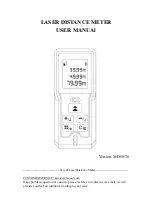
TURTLE
TOUGH
®
45
1. Unscrew the membrane cap per procedures.
2. Carefully rinse the electrode finger and dry it carefully with a clean cloth.
3. Connect the sensor to the indicator/controller and wait for approx. 5 minutes.
4. Read the signal from the cell on the analyser or measure it with a digital multimeter.
The measured value should be approx. 4 mA.
– If the sensor signal corresponds to roughly this value, the electronics are likely to be working
correctly.
– If the measured value is significantly different from the value stated above, the sensor must be sent
to the manufacturer for inspection.
The zero point should be tested after the electronics have been tested.
1. Prepare the sensor for startup.
2. Connect the sensor to the analyser.
3. Carefully place the sensor in a beaker with clean tap water (without disinfectant).
4. Move the sensor around in the beaker for approx. 30 s (without creating air bubbles).
5. Leave the sensor in the beaker for > 1 hour and wait for the settling time to elapse.
6. Read the signal from the cell on the analyser or measure it with a digital multimeter.
7. The sensor signal should be around the zero point.
– If the signal from the measuring cells has a value of around zero, the zero point is likely to be
working.
– If the measured value deviates significantly from zero, maintenance must be carried out on the
sensor and the "zero point test" must be repeated. You must bear in mind that a working electrode
which has just been cleaned has a relatively high zero point.
In this case, the measuring cells will take a few days to reach their lowest zero point.
– If the measured value is not around zero, even after maintenance has been carried out, the sensor
must be sent to the manufacturer for inspection.
In general, the zero points of sensors with an extremely small measuring range or which are more sensitive
are slightly higher than for measuring cells with large measuring ranges or which are less sensitive.
Summary of Contents for TT-ISE-CL2
Page 2: ...TURTLE TOUGH 2...
Page 34: ...TURTLE TOUGH 34 8 9 10 analyser...
Page 35: ...TURTLE TOUGH 35 analyser...







































